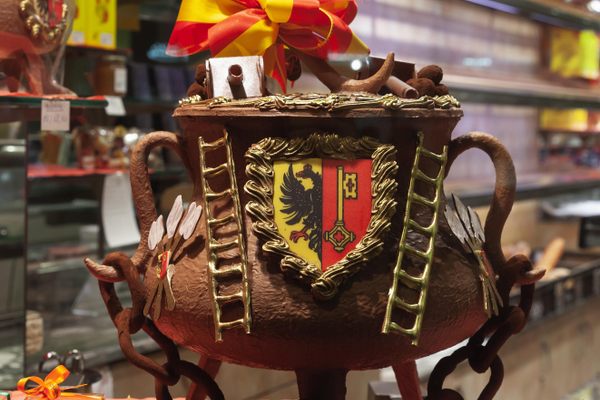Antwerp is the capital of chocolate, selling it in various shapes and flavors, ranging from little peeing boys (manneken pis) to more traditional shapes such as animals and happy faces. But one of the most popular shapes is a severed hand.
As the myth behind Antwerpse handjes (Antwerp hands) goes, there once was a mighty giant called Druon Antigoon. The giant terrorized the people by demanding tolls to anyone passing his lair near the Scheldt river. When someone could not pay, the giant chopped off their hand and threw it into the river. One day, however, a brave soldier named Silvius Brabo defeated the giant in battle, then chopped off his hand and threw it into the river. Some suggest that the name Antwerp comes from the Dutch for the words hand werpen or “hand throwing” (though this is debated among etymologists). Over the years, severed hands have became a symbol of the city, first as cookies decorated with sliced almonds, and later as chocolates filled with praline or marzipan. Outside Antwerp’s city hall, the Brabo Fountain even features a statue of the hero tossing the giant’s hand.
While the legend about Antwerp’s chocolate hands tells a story of sweet victory, there is a more complex, bitter, and oft-overlooked history associated with the symbol of severed hands in Belgium. From 1885 to 1908, the Congo Free State was a private holding controlled by Belgium’s King Leopold II. Leopold grew rich, exporting valuable Congolese resources such as rubber and ivory. To do this, the king’s army forced many Congolese into labor. And for those who did not meet quotas? Soldiers would sever their hands and present them to officials as proof of enforcement. And while the news of Leopold’s horrific regime sparked an international outcry that resulted in his losing control over the state in 1908, the Congo remained a Belgian colony until regaining its independence in 1960.
Though they may seem like simple candies, the chocolate hands represent a complex story of symbolism. The triumphant myth of vanquishing the giant is tempered by the less-than-savory realties of exploitation and colonization in the Congo. Perhaps the best way to consume such complicated stories is not by rewriting history or rejecting their edible symbols, but rather by using them as tool for discussion about how to build a better, sweeter future.
Written By
 CoolCrab
CoolCrab
Sources
- focusonbelgium.be/en/facts/did-you-know-they-eat-little-hands-antwerp
- sites.northwestern.edu/akih/2013/02/21/chocolates-as-cultural-blind-spots-responding-to-civilization/
- www.academia.edu/29771024/Antwerps_Appetite_for_Congolese_Hands
- chocolateclass.wordpress.com/tag/chocolate-hands/
- www.amazon.com/King-Leopolds-Ghost-Heroism-Colonial/dp/0618001905
- books.google.com/books?id=9k4GDAAAQBAJ&pg=PA29&lpg=PA29&dq=austrian+and+french+occupation+of+belgium&source=bl&ots=JVktXj16X0&sig=goWBPEFCa-KjPuMO4VXovLUP8OA&hl=en&sa=X&ved=2ahUKEwifsoW_rZPeAhWwdN8KHT4xDqk4ChDoATADegQIBRAB#v=onepage&q&f=false
- academic.oup.com/fh/article-abstract/16/1/53/619268?redirectedFrom=PDF
- www.digitaljournal.com/blog/11297
- www.nytimes.com/2005/10/21/movies/the-horrors-of-belgiums-congo.html?mtrref=www.google.com















